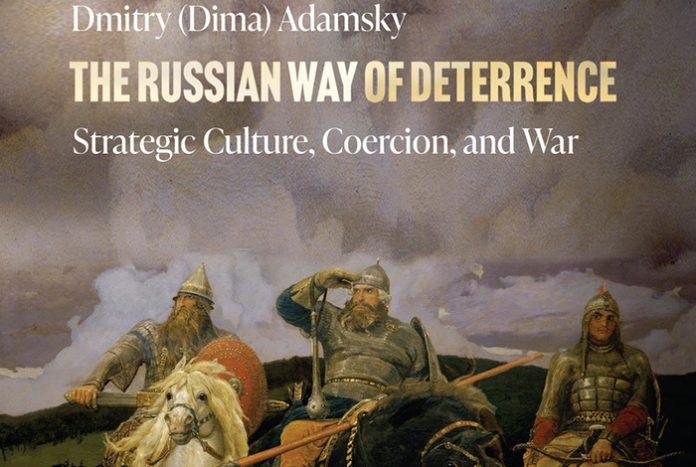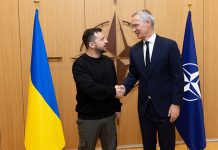“Dima Adamsky points out that for Russia deterrence is an act (including the limited use of force) rather than a rhetorical threat and is practiced prior to and during all phases of war.” – Luke Turrell casts a critical eye over The Russian Way of Deterrence.
Read the digital document above or continuing reading below.
LOST IN TRANSLATION?
TITLE: The Russian Way of Deterrence: Strategic Culture, Coercion, and War
AUTHOR: Dmitry (Dima) Adamsky
REVIEWER: Major Luke Turrell, Executive Officer, CHACR
One of the challenges of language is when the same word or term is used but the meaning is different. To a European or American ear, a British person saying ‘that’s a brave decision’ or ‘I’ll bear it in mind’ may mean simply that ‘they think I’m courageous’ and ‘they’ll probably complete that task’. But of course, the British person is likely to mean ‘you’re totally insane’ and ‘I’ve forgotten it already’. Equally, when the US Army hears the term ‘Armoured Brigade Combat Team’ they might imagine that the UK military formation has the same structure and range of capabilities as an American ‘Armoured Brigade Combat Team’.
This confusing and potentially dangerous distinction is at the heart of Dima Adamsky’s new book, The Russian Way of Deterrence. The author draws out that Russians have a fundamentally different view of the practice of deterrence and explains (in varying degrees of depth) how and why they do so. Whilst coercion, alongside diplomacy and war, are universal tools of statecraft and geopolitical influence, Adamsky’s point is they are not practiced universally. And this consideration is even more important to consider, ironically, when trying to deter another state. Having previously written Russian Nuclear Orthodoxy (2019) and The Culture of Military Innovation (2010), Adamsky, a Professor at the Reichman University in Israel, is clearly a serious academic – as demonstrated by the traditionally effusive quotes on the back of his latest book being, unusually, from genuine Russia scholars rather than well-known former politicians or Generals.
In this readably concise title, Adamsky starts by considering three interconnected factors (history, culture and concepts) that influence how Russia sees deterrence. This can be as simple as the etymology of the word deterrence; in English deterrence comes from the root words ‘terror’ or ‘fear’. By contrast, in Russian, sderzhivanie, means an action that holds back or restrains. Adamsky briefly but systematically also considers the impact of cultural practices such as reflexive control, military cunning and suffering (also a broader Russian cultural influence). He then explores, as a result of these factors, how Russia does deterrence using conventional forces, nuclear weapons and information in ways that are far more interconnected than within the Western doctrinal or conceptual canon. He points out that for Russia deterrence, building on the linguistic basis of the word, is an act (including the limited use of force) rather than a rhetorical threat and is practiced prior to and during all phases of war. It is a concept of employment that differs to the more familiar ‘escalation ladder’ of western military and diplomatic thought and is characterised in the West, although not in Russia, as ‘escalate to de-escalate’. Adamsky’s section on the overall implications for NATO security policy illustrates some useful points for practitioners. In the author’s view, the Kremlin prior to 2022 took for granted the West’s ability to decipher its coercive signalling although notes the task was made more difficult because much of Russia’s coercive behaviour has its basis in internal, departmental competition for resources.
Adamsky also makes an important and often overlooked point at the beginning of the book. National capitals traditionally consider ‘how do we deter [insert country]?’. Adamsky insists the question must be more specific and a better one to pose would be ‘how do we deter [insert country] from conducting catastrophic attacks (and accept the fact of annoying but non-existential threats)?’. He concludes: “Examining Russian conduct through what some Western experts see as the ‘universal logic of deterrence’… is at best unhelpful. At worst it could result in mirror imaging, intelligence misdiagnosis and misperceptions leading to security dilemmas and inadvertent escalations.”
Should you be looking for any further reason to read this book, the final chapter lists dozens of Master’s and PhD research questions, all of which set the mind racing and deserve to be considered and answered by future students – hopefully in as rigorous and accessible way as Adamsky does in The Russian Way of Deterrence.
Published by Stanford University Press, Paperback, ISBN: 9781503637825





